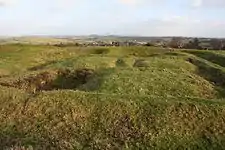| Stowey Castle | |
|---|---|
| Somerset, England | |
 Stowey Castle | |
 Stowey Castle | |
| Coordinates | 51°08′56″N 3°09′49″W / 51.1490°N 3.1637°W |
| Grid reference | grid reference ST187395 |
| Type | Motte and bailey |
| Site information | |
| Condition | Earthworks remain |
Stowey Castle (or Nether Stowey Castle known locally as The Mount) was a Norman motte-and-bailey castle, built in the 11th century, in the village of Nether Stowey on the Quantock Hills in Somerset, England. It has been designated as a Scheduled Monument,[1] the foundations of the keep are also a Grade I listed building.[2][3]
Details

The Castle is sited on a small isolated knoll of Leighland Slates of the Devonian series, about 390 feet (119 m) high. It consisted of a square keep, (which may have been stone, or a wooden superstructure on stone foundations) and its defences, and an outer and an inner bailey.[4] The mount is 29 feet (9 m) above the 6 feet (2 m) wide ditch which itself is 7 feet (2 m) deep. The motte has a flat top. Central area occupied by approximately square foundations 33 feet (10 m) by 33 feet (10 m) with internal divisions.[5]
Alfred of Spain is the Norman Lord of Stowey recorded in Domesday and the building of the castle is normally attributed to him or to his daughter Isabel. The earliest written reference to the castle is in a forged charter of 1154.[6]
The top of the motte was excavated by amateurs in the 19th century but no record was made of any finds. The mounds around the top of the motte are assumed to be spoil heaps from these excavations to clear the foundations of the keep, although it has also been suggested that they may be the remains of towers.[7] The blue lias rubble foundations are the only visible structural remains of the castle which stood on the conical motte surrounded by a ditch approximately 820 feet (250 m) in circumference.[8]
The castle was destroyed in the 15th century, which may have been as a penalty for the local Lord Audley's involvement in the Second Cornish Uprising of 1497 led by Perkin Warbeck.[9] Some of the stone was used in the building of Stowey Court in the village.[10]
See also
References
- ↑ "Stowey Castle, the site of St Michael's Chapel and a medieval kiln site, Nether Stowey - 1019421 | Historic England". historicengland.org.uk. Retrieved 10 June 2022.
- ↑ "REMAINS OF KEEP TO STOWEY CASTLE, Nether Stowey - 1059074 | Historic England". historicengland.org.uk. Retrieved 10 June 2022.
- ↑ "Stowey Castle". Pastscape National Monument Record. English Heritage. Retrieved 24 July 2011.
- ↑ "Nether Stowey Castle orientation leaflet" (PDF). Quantock Online. Retrieved 11 March 2008.
- ↑ "Stowey Castle, Nether Stowey". Somerset Historic Environment Record. Retrieved 11 March 2008.
- ↑ Dunning, R W (1981). "The Origins of Nether Stowey". Somerset Archeol Natur Hist. 125: 124–6.
- ↑ Riley, Hazel (2004). Nether Stowey Castle Survey Report. English Heritage. ISSN 1478-7008.
- ↑ "Remains of Keep to Stowey Castle". historicengland.org.uk. Retrieved 10 March 2008.
- ↑ "Nether Stowey". Quantock Online. Retrieved 10 March 2008.
- ↑ Waite, Vincent (1964). Portrait of the Quantocks. London: Robert Hale. ISBN 0-7091-1158-4.